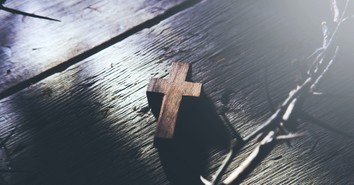What Is the Correct Reading Order for The Chronicles of Narnia?

SPECIAL OFFER: Enroll in this free online course on C.S. Lewis today!
As the Star Wars universe evolves and expands, debate continues over how newcomers should watch the series. For many die-hard fans, however, the option remains clear: the first exposure to the movies should follow the order in which they were initially released.
Starting with the Star Wars prequels inherently robs first-time audiences of the emotional impact of the original trilogy’s plot revelations (including a particular character’s ancestry). We can assert this widely accepted truth even though George Lucas himself says a chronological order is “the way to do it right.”
In a literary galaxy far, far removed from Star Wars, there are disagreements as to what order newcomers should read the Chronicles of Narnia in. Should they follow the original publication order (as follows)?
1. The Lion, the Witch and the Wardrobe (1950)
2. Prince Caspian: The Return to Narnia (1951)
3. The Voyage of the Dawn Treader (1952)
4. The Silver Chair (1953)
5. The Horse and His Boy (1954)
6. The Magician’s Nephew (1955)
7. The Last Battle (1956)
Or should they follow the “George Lucas model”—i.e., a chronological order? This is the sequence in which the book sets are currently being published (as follows):
1. The Magician’s Nephew
2. The Lion, the Witch and the Wardrobe
3. The Horse and His Boy
4. Prince Caspian
5. The Voyage of the Dawn Treader
6. The Silver Chair
7. The Last Battle
The Discarded Order
The reason for the renumbering of the books is explained by Douglas Gresham, stepson of C.S. Lewis:
[W]hen HarperCollins took over the global production of these books and publication of them, they…asked, “What order do you think we ought to do them in?” And I said, “Well … I actually asked Jack himself what order he preferred and thought they should be read in. And he said he thought they should be read in the order of Narnian chronology.” So I said, “Why don't you go with what Jack himself wanted?”
This quote seems to answer the matter with finality: the best way to read the books is not the order in which they were originally published, but the order in which they take place within the world of Narnia.
Why, then, does the official website of C. S. Lewis claim “scholars almost universally agree” that the publication order—not the chronological order—is the best option? Why is The Lion, the Witch and the Wardrobe—not The Magician’s Nephew—generally considered the best introduction to Narnia?
The reasons are manifold, but we will focus on three of them—the last of which is regularly overlooked.
1. The Lion, the Witch and the Wardrobe Comes First
C. S. Lewis didn’t initially set out to write an entire series of books. As he himself said, “When I wrote The Lion I did not know I was going to write any more.” As such, Lewis uses The Lion as the official introduction to the world of Narnia. The Pevensies are a stand-in for the reader: your experience is designed to imitate theirs and your knowledge of Narnia to grow alongside theirs. That’s why The Lion says at one point, “None of the [Pevensie] children knew who Aslan was any more than you do.” It is assumed the reader has no prior knowledge of the king of Narnia.
Now, in some cases, an author might employ a technique called dramatic irony. This is when the reader is aware of a situation in or related to the plot that the characters in the story remain unaware of. With dramatic irony, you know more than the characters do, and that knowledge creates a sense of humor or tension (depending on the situation and the intent of the author).
Lewis isn’t utilizing dramatic irony in The Lion, the Witch and the Wardrobe; he’s not presuming you already know how Narnia was created, or why a lamp exists in the middle of a forest, or how a wardrobe can transport the Pevensies from one realm to another. On the contrary, he’s expecting you to not know these things. The mystery and discovery in which the Pevensies are engulfed are designed to engulf the first-time reader as well.
As Narnia scholar Devin Brown points out, reading The Lion first helps us “walk with and not ahead of the four Pevensie children. . . . Reading this story first is the only way we can share their wonder.”
2. The Magician’s Nephew Is a Prequel
With The Magician’s Nephew, Lewis does utilize dramatic irony. He assumes the reader is already familiar with the world of Narnia. That is why he references, for example, a particular lamp post (among other elements from The Lion). The characters in the story have no idea of its significance—but the reader does.
To quote author Charlie W. Starr,
Nephew gains mythic power by being read in order of publication. By itself, Nephew [sic] is good, but what makes it wonderful is that we read about a world we’ve already fallen in love with (by reading the other books first). . . . The power in Nephew is born out of its status as a true prequel. Its meaning is made deeper, more wonderful, because of the tales we’ve encountered before.
Starting the series with The Magician’s Nephew has an unintended consequence: instilling within first-time readers what we might punningly call “chronological snubbery”; instead of expanding on what was revealed in The Lion, it reduces and diminishes the mystery and discovery of The Lion.
Rather than stealing The Lion’s thunder, Nephew can (when read in the right order) act as an excellent bookend to The Lion: it circles back to the first antagonist introduced (Jadis), showing us where she came from; it reveals the origins of Lantern Waste, the meeting place for Lucy and Tumnus; and it ends where The Lion begins—with a particular magical wardrobe.
Due to the above considerations, Lewis scholar Michael Ward writes, “it is a mistake for publishers to put the number 1 on the spine of The Magician’s Nephew or to print it first in multi-volume [single] editions.”
3. C. S. Lewis Didn’t Say What You Think He Said
This third factor has been almost universally misunderstood. NarniaWeb sets the stage:
In 1957, an 11-year-old boy named Lawrence Krieg was preparing to read the Narnia books for a second time. Lawrence wondered if he should re-read them chronologically, but his mother felt he should stick with the original published order. So, Lawrence wrote a letter to the author…
The answer Lewis gave to this letter is Exhibit A for those who promote a chronological reading. So what exactly did he say?
"I think I agree with your order for reading the books more than with your mother’s. The series was not planned beforehand as she thinks. . . . So perhaps it does not matter very much in which order anyone read them."
How could someone promote a publication-order reading in light of this quote? The most obvious answer is that Lewis himself never requested a renumbering of the books. However, there’s a second—and, arguably, more powerful—answer to that question.
As we learned from NarniaWeb, Lewis is answering a question about reading Narnia for the second time. After having already gone through the series, Lawrence “wondered [how] he should re-read them.” His question isn’t about what a first-timer should do; it’s about what Lewis thinks a second-timer should do. If you’ve already completed the series, the order in which you do a second reading isn’t as important.
A Joy Observed
Admittedly, choosing a chronological reading order likely won’t scar first-timers for life. But that’s almost beside the point. The reason why a person picks up a book isn’t the low bar motive of “I guess this won’t scar me.” No, he wants to read a new story because he thinks he’ll enjoy or benefit from it.
Similarly, the key deficiency of the chronological approach to Narnia for first-timers is not that it’s devastatingly bad, but that it misses out on something inherently better. As Lewis fan and film critic Steven D. Greydanus writes,
[R]eaders (or those who are read to) who first encounter the [Narnia] stories chronologically…will not be conscious of anything being missing. But the specific pleasures…of the unexplained mysteries in The Lion and the satisfying explanations in Magician’s Nephew will have been lost nonetheless. They will not be conscious of this as a loss, but it’s there.
The main problem with the reordering of the series, says Greydanus, “is not anyone personally preferring the chronological order, or even reading the books that way to their kids, but the publishers systematically cheating generations of readers en masse of what should be the default enumeration, the original publishing order.”
Return of the First Order
As much as fans of Star Wars appreciate what George Lucas created, many of them reject his notion that first-comers should watch the movies in chronological order. A similar situation exists in regards to the fantastical universe Lewis created.
Some might cringe at the comparison of Lewis and Lucas. Sure, their names may sound similar, but so do grapes and grapefruit. The two are vastly different. Nevertheless, a serial story is generally best enjoyed in the order in which it was released, because everything that comes after the first installment is building on it and assuming a knowledge of it.
Consequently, when picking up The Chronicles of Narnia for the first time, the reading order you choose is not inconsequential. And if there is a more advantageous way to explore this beloved fantasy series, why not take it? Why not revel, as much as possible, in the awe and wonder of Aslan’s world? Why not travel through Narnia on the path first blazed by Lewis himself?
To borrow a popular quote from the Star Wars universe, “This is the way.”
Photo Credit: ©Pexels/Pixabay

Originally published April 23, 2021.





